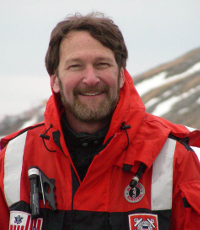James R. Lovvorn
Professor Emeritus

Office:445 Life Science II
Phone: 618-453-4127
Email: lovvorn@siu.edu
My group seeks to understand linkages between mobile top predators (birds) and aquatic food webs. We use simulation models to link field and laboratory studies of the foraging energetics of birds with the quality and dispersion of prey, and to predict prey availability as a function of food web interactions.
Education
Ph.D., University of Wisconsin-Madison.
Courses taught
Zool 467 (Ornithology), ZOOL/PLB 490 (Energetics, Food Webs, and Ecosystems)
Areas of interest
Waterbird ecology and energetics; food webs of marine and fresh waters.
Selected Recent Publications
Lovvorn, J. R., C. A. North, J. M. Kolts, J. M. Grebmeier, L. W. Cooper, and X. Cui. 2016. Projecting the effects of climate-driven changes in organic matter supply on benthic food webs in the northern Bering Sea. Marine Ecology Progress Series 548:11-30.
Lovvorn, J. R., A. R. Rocha, S. C. Jewett, D. Dasher, S. Oppel, and A. N. Powell. 2015. Limits to benthic feeding by eiders in a vital Arctic migration corridor due to localized prey and changing sea ice. Progress in Oceanography 136:162-174.
Lovvorn, J. R., E. M. Anderson, A R. Rocha, W. W. Larned, J. M. Grebmeier, L. W. Cooper, J. M. Kolts, and C. A. North. 2014. Variable wind, pack ice, and prey dispersion affect the long-term adequacy of protected areas for an Arctic sea duck. Ecological Applications 24:396-412.
North, C. A., J. R. Lovvorn, J. M. Kolts, M. L. Brooks, L. W. Cooper, and J. M. Grebmeier. 2014. Deposit-feeder diets in the Bering Sea: potential effects of climatic loss of sea ice-related microalgal blooms. Ecological Applications 24:1525-1542.
Lovvorn, J. R., S. E. W. De La Cruz, J. Y. Takekawa, L. E. Shaskey, and S. E. Richman. 2013. Niche overlap, threshold food densities, and limits to prey depletion for a diving duck assemblage in an estuarine bay. Marine Ecology Progress Series 476:251-268.
Lovvorn JR, Grebmeier JM, Cooper LW, Bump JK, Richman SE (2009) Modeling marine protected areas for threatened eiders in a climatically changing Bering Sea. Ecological Applications 19:1596–1613.
Richman SE, Lovvorn JR (2009) Predator size, prey size, and threshold food densities of diving ducks: does a common prey base support fewer large animals? Journal of Animal Ecology 78:1033–1042.
Anderson EM, Lovvorn JR, Esler D, Boyd WS (2009) Using predator distributions and diet biomarkers to define marine protected areas: sea ducks and spawning herring. Marine Ecology Progress Series 386:287–302.
Corcoran RM, Lovvorn JR, Heglund PJ (2009) Long-term change in limnology and invertebrates in Alaskan boreal wetlands. Hydrobiologia 620:77–89.
Hart EA, Lovvorn JR (2005) Patterns of macroinvertebrate abundance in inland saline wetlands: a trophic analysis. Hydrobiologia 541:45–54.
Richman SE, Lovvorn JR (2004) Relative foraging value to Lesser Scaup ducks of native and exotic clams from San Francisco Bay. Ecological Applications 14:1217–1231.
Lovvorn, J. R., and E. A. Hart. 2004. Irrigation, salinity, and landscape patterns of natural palustrine wetlands. Pages 105-129 in M. C. McKinstry, W. A. Hubert, and S. H. Anderson, eds. Wetland and riparian areas of the Intermountain West: ecology and management. Univ. of Texas Press, Austin. 319 pp.
Hart EA, Lovvorn JR (2003) Algal vs. macrophyte inputs to food webs of inland saline wetlands. Ecology 84:3317–3326.
Kruse, K. L., J. R. Lovvorn, J. Y. Takekawa, and J. Mackay. 2003. Long-term productivity of Canvasbacks (Aythya valisineria) in a snowpack-driven desert marsh. Auk 120:107-119.
For more information on my research program, please see my lab webpage.
